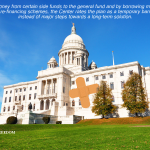Center Issues Statement on Governor’s Proposed Healthcare Tax
|
Summary: Explanations by the Raimondo administration about the Governor’s proposed surcharge on health insurance premiums appear to be misleading. The truth about the new tax expose four major concerns about how it is NOT comparable to the would-be federal exchange tax.
FOR IMMEDIATE RELEASE
March 17, 2015
|
|
Truth about the proposed HealthSource RI Tax
|
| Is Not Commensurate in Scope to Federal Exchange Tax: Tax Base, Tax Levy, Tax Certainty, and Next Steps are Considerably Different |
|
Providence, RI — Explanations by the Raimondo administration about the Governor’s proposed surcharge on health insurance premiums appear to be misleading. Designed to raise money to partially fund continued state operation of the controversial HealthSource RI exchange, the tax is being positioned by administration officials as comparable to the fees that would be charged if the exchange were to be returned to the federal government. However, as broached in a recent post in The Ocean State Current, there are a number of major differences between the federal tax and Governor Raimondo’s proposed tax:
First, who gets taxed? Under a federally run exchange, only those who purchase a policy through the exchange, or who purchase an identical policy outside of the exchange, would be taxed. But, as the Center has been projecting for years, because of Rhode Island’s small size and low enrollment numbers, not enough revenue can be raised without charging exorbitant per policy fees.
Under Raimondo’s plan to pay for HealthSource RI’s high projected costs, there would be an assessment on ALL individual and small business policies in the state, whether purchased inside or outside of the exchange.
Also of note, vocal special interest groups, such large corporations and union shops, would appear to be exempt from the tax; yet another special interest handout?
Second, how much tax? Under the federal plan, it was estimated that the 3.5% federal rate assessment based on the 30,000 or so who are currently purchasing insurance through the exchange, would result in about $5-6 million in fees. The Governor’s tax is projected to raise an ‘initial’ $6.2 million in half a year, or about $12 million in annual revenues, making it at least twice as expensive for Ocean State policyholders as the federal option.
Additionally, the proposed 3.8% and 1% tax on individuals and small employers, respectively, is significantly higher than similar 1.35% and 2.5%-3% taxes in Connecticut and Massachusetts, which can afford the lower rates, as they can be spread across a significantly higher number of policy holders.
Third, a fixed tax rate? Use of the term ‘initial premium assessment’ indicates a potential slippery slope. In fact, if HealthSource RI’s expenses rise, or when federal funds disappear, the health and human services secretary is empowered to raise rates for this tax in future years, while the federal plan is statutorily fixed.
Fourth, a stepping stone to state control? Maintaining the exchange under state operation also maintains the threat of further state control over Rhode Island’s healthcare industry, with separate legislation in 2014 (H7819) and 2015 (H5387) already seeking to give government unprecedented new powers. A single-payer system, such as that advocated for by the new HealthSource RI Director, has long been a goal of progressive lawmakers. Under a federal exchange, this threat is virtually eliminated
|


Leave a Reply
Want to join the discussion?Feel free to contribute!